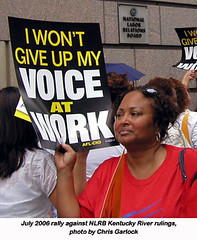2 reasons to retain consultants
There is a lot of dissent amongst neighborhood groups and elected officials about how planning offices retain consultant teams to do neighborhood and commercial district planning studies.
There are at least two reasons why it is a good thing to do.
1. Government employees are constrained by the political and bureaucratic process to favor system maintenance, with only a modicum of change allowed. As it is, since government contracts for public participation and develops the scope of work for the project, these processes are considerably constrained as it is.
(Even as a semi-government employee now--some of my salary is paid for out of funds provided to the Main Street program from the DC Government -- I find that I have to self-censor some of my own non-work related statements and activities on certain city planning and development issues, especially in the same Ward.)

Sometimes you do...
It is still controversial in government/amongst elected officials/neighborhood thinking to advocate for people over cars, advancing non-automobile mobility, and focusing on mixed use rather than segregated use, some density, etc.
In short, consultants (and advocates) can say things that people working for government cannot say.
(The first or second question from the audience at the final presentation of virtually any presentation is about maintaining the primacy of the car. And almost never ever do consultants or planning types explain with numbers the link between density and the use of transit -- in the DC region, near transit stations in denser areas, at least 1/2 the trips are made on transit. So adding density increases, not decreases, the likelihood of transit use. Of course that is only true if you have a decent transit system to begin with.)
2. Even "outside of the box" thinkers like me get deadened by our lives of ordinariness and it's good to have outsiders come in and offer a fresh look. Maybe they just confirm what you think. Maybe they lead you into some great ideas. Maybe they have terrible ideas (not usually but sometimes). Or by offering an idea, they help you think about things in new exciting innovative ways.
------
Note that student studios can be good, but the suggestions can be pretty rote, depending on how much experience they have. Some of the student architecture studios at Catholic University have been quite good. I have been less impressed by a couple studios comprised of UMD students. It's been said that undergrads are hungrier and more open, compared to graduate students.
------
Still and all, most studies say the same thing. Make the streetscapes nicer and focus on balancing the mobility needs of modes other than the car. Strengthen transit. Focus and strengthen businesses. Develop incentive programs. Find the political and economic will to implement change.
So a good study looks a lot like other ones. If you read such studies for fun and insight, after you read a few, say 10, you're pretty knowledgeable about the trends in the field. Of course, areas around sports stadiums, waterfronts, etc., have slightly different characteristics.
-------
And, I think neither consultant teams nor regular planning offices do a very good job about explaining the ur- principles of what and why to help create, stabilize, and/or extend the qualities that make places great.
Of course, Jane Jacobs did, in part in Death and Life of Great American Cities. Similarly, Belmont's Cities in Full extends these principles. But the report by DC's own Office of Planning, Trans-Formation: Recreating Transit-Oriented Neighborhood Centers in DC: Design Handbook, is also an excellent read.
For design, Jan Gehl's Close Encounters with Buildings, Cy Paumier's Creating a Vibrant City Center, and the Urban Design Compendium published by English Partnerships are all very good. The latter is available on their website, or you can request a printed copy that they will send to you--free!
Lately, I've been thinking we need to make these principles up in 10-20 boards and take them around.
PPS, when they do projects, they spend the first couple hours laying out the basic ideas of what makes great places. See How to Turn a Place Around.
Oh another good source about the process are the one pagers from Crandall-Arambula:
- Community Vision
- Public Involvement
- Design Guidelines
- Pedestrian Friendly Streets
- Public Squares
- Downtown Plans
- Station Area Planning
- Build Out Analysis
- Final Reports
- Implementation
P.S. To reiterate, one thing that bugs me about these processes, which says that there is something that we are not doing, is my sense that with each planning iteration, resident-citizen participants don't necessarily get "smarter" and more knowledgeable. What I mean is that if you particpate in two or more planning study exercises, theoretically, you should know more and have better and better ideas each time. I don't see it happening. I don't think that there can be any clearer evidence that we aren't teaching the basic principles in ways that people can understand.
Speaking of basic principles, the Crandall-Arambula papers do that on the process, and maybe Dan Burden's piece on How Can I Find and Help Build a Walkable Community? does it more generally. This article on Fred Kent and the Project for Public Spaces is also pretty good: Pride of Place from Governing Magazine.
Labels: civic engagement, land use planning, transportation planning, urban design/placemaking



0 Comments:
Post a Comment
<< Home